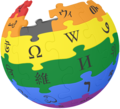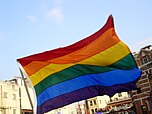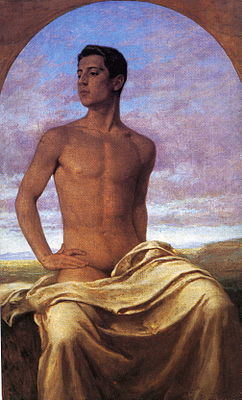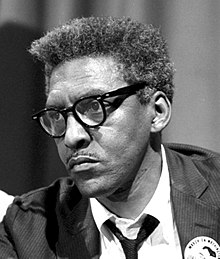Portal:LGBT
| Main page | WikiProjects & Things you can do |

|
The LGBTQ+ Portal |

|

|

|
Introduction LGBT is an initialism that stands for "lesbian, gay, bisexual, and transgender". It may refer to anyone who is non-heterosexual, non-heteroromantic, or non-cisgender, instead of exclusively to people who are lesbian, gay, bisexual, or transgender. A variant, LGBTQ, adds the letter Q for those who identify as queer (which can be synonymous with LGBT) or are questioning their sexual or gender identity. Another variation, LGBTQ+, adds a plus sign "represents those who are part of the community, but for whom LGBTQ does not accurately capture or reflect their identity". Many further variations of the acronym exist, such as LGBT+ (simplified to encompass the Q concept within the plus sign), LGBTQIA+ (adding intersex, asexual, aromantic and agender), and 2SLGBTQ+ (adding two-spirit for a term specific to Indigenous North Americans). The LGBT label is not universally agreed to by everyone that it is generally intended to include. The variations GLBT and GLBTQ rearrange the letters in the acronym. In use since the late 1980s, the initialism, as well as some of its common variants, functions as an umbrella term for marginalized sexualities and gender identities. LGBT is an adaptation of LGB, which in the mid-to-late 1980s began to replace the term gay (or gay and lesbian) in reference to the broader LGBT community. When not inclusive of transgender people, the shorter LGB is still used. (Full article...) Selected article - Bisexuality is a romantic or sexual attraction or behavior toward both males and females (gender binary), to more than one gender, or to both people of the same gender and different genders. It may also be defined to include romantic or sexual attraction to people regardless of their sex or gender identity, which is also known as pansexuality. The term bisexuality is mainly used for people that have both heterosexual and homosexual attraction. Bisexuality is one of the three main classifications of sexual orientation along with heterosexuality and homosexuality, all of which exist on the heterosexual–homosexual continuum. A bisexual identity does not necessarily equate to equal sexual attraction to both sexes; commonly, people who have a distinct but not exclusive sexual preference for one sex over the other also identify themselves as bisexual. (Full article...)Selected biography -Bayard Rustin (/ˈbaɪ.ərd/ BY-ərd; March 17, 1912 – August 24, 1987) was an American political activist, a prominent leader in social movements for civil rights, socialism, nonviolence, and gay rights. Rustin was the principal organizer of the March on Washington for Jobs and Freedom in 1963. Rustin worked in 1941 with A. Philip Randolph on the March on Washington Movement to press for an end to racial discrimination in the military and defense employment. Rustin later organized Freedom Rides, and helped to organize the Southern Christian Leadership Conference to strengthen Martin Luther King Jr.'s leadership; he taught King about non-violence. Rustin worked alongside Ella Baker, a co-director of the Crusade for Citizenship, in 1954; and before the Montgomery bus boycott, he helped organize a group called "In Friendship" to provide material and legal assistance to people threatened with eviction from their tenant farms and homes. Rustin became the head of the AFL–CIO's A. Philip Randolph Institute, which promoted the integration of formerly all-white unions and promoted the unionization of African Americans. During the 1970s and 1980s, Rustin served on many humanitarian missions, such as aiding refugees from Vietnam and Cambodia. (Full article...)Selected quote -
Current events
Selected image - This 1908 painting by German artist Paul Höcker depicts Nino Cesarini, the Italian lover of Baron Jacques d'Adelswärd-Fersen. Fersen had fled from France after a sex scandal and built a mansion on Capri, Villa Lysis, where he lived together with Cesarini. The two edited a short-lived literary magazine together, Akademos, which was partly a discreet defense of homosexual love. A romanticized account of their relationship is given by Roger Peyrefitte in his 1959 novel L'Exilé de Capri ("The Exile of Capri").
Did you know… -
This month's birthdays
Selected lists
Related portalsFeatured contentThe following articles and lists have been identified as some of the best produced by the Wikipedia community:
TopicsCategoriesAssociated WikimediaThe following Wikimedia Foundation sister projects provide more on this subject:
Discover Wikipedia using portals |
























